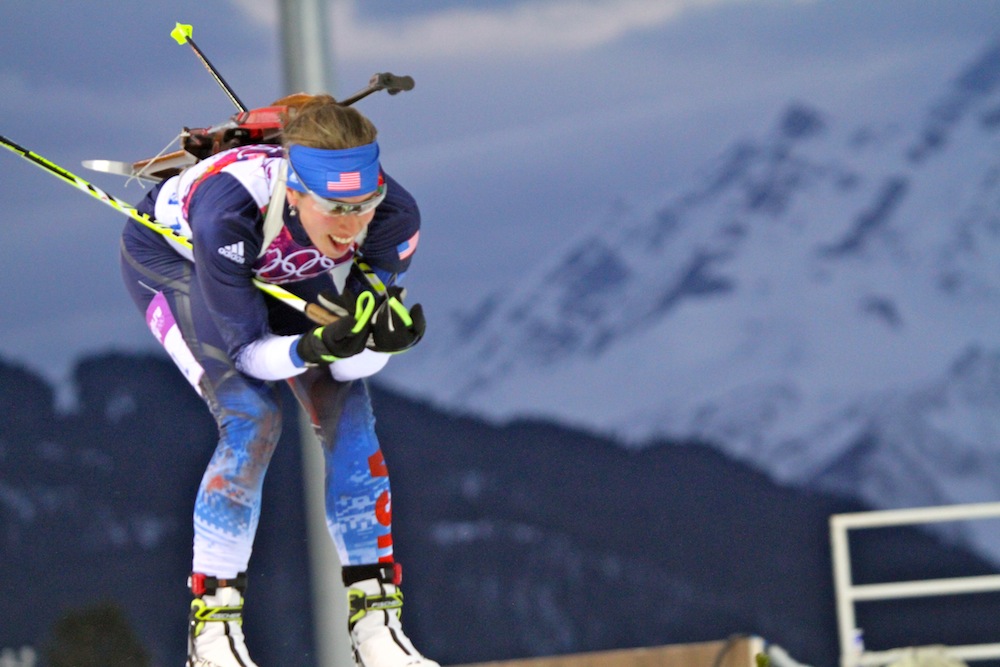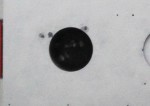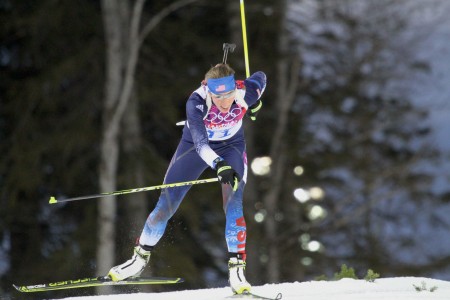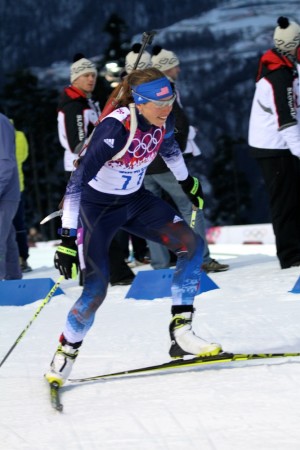
FasterSkier’s coverage is made possible through the generous support of Rudy Project.
SOCHI, Russia — Susan Dunklee was this close to an Olympic medal.
Her one miss in Sunday’s sprint race in Sochi was about a centimeter outside of the 10 o’clock edge of the target.
The errant bullet forced Dunklee into the penalty loop and pushed her down to 14th place on the day — tantalizingly close to the

podium, but still good enough for the best-ever Olympic finish in a sprint race by an American woman, in Dunklee’s first-ever appearance at the games.
“You play the what-if game, and it’s a very small fraction of a second that can make or break that moment,” she said afterwards, reflecting on the missed shot—her very last one, after she’d knocked down nine in a row. “I thought about it for just a little too long.”
The miss meant that Dunklee had to ski a penalty lap, which added about 23 seconds to her time. She ended the race 22 seconds behind Russian Olga Vilukhina, the second-place finisher.

The result left Dunklee, 27, and her coaches simultaneously shaking their heads, but also enthusiastic about what boiled down to a solid performance.
Coming into the race, her first-ever Olympic competition, she had been nervous, “more nervous than I ever have been before a race,” she said.
In Sochi, she said, “you see the rings everywhere and you’re thinking about it.”
Dunklee is a second-generation Olympian; her father, Stan Dunklee, competed in the 1976 and 1980 games as a cross-country skier.
“It’s something I’ve dreamed about since I was a kid. I always believed I was capable of it because of my role model, my dad,” she said.
Once she made it to the venue, however, “it was just normal race routine,” she added.
Dunklee’s first two laps were 17th– and 18th-fastest, respectively, in the 84-woman Olympic field, before she hit the gas for her last loop, which only three women skied more quickly.
U.S. Head Coach Per Nilsson said that the tough course in Sochi played to Dunklee’s strengths.
“It’s a lot of climbing, and you need to just put in the hammer and go,” he said. “But she’s good at that.”
Dunklee said she concentrated on the uphills, especially the long one that curved up and above the shooting range — a steep climb that flattened into a more gradual pitch towards the top.
“A lot of people kind of stop fighting after the steepness ends,” she said. “But it’s still going up, and you can lose a lot of time if you’re not fighting all the way through that gradual part…so that’s where I focused.”
The lone miss, she said, came as a surprise after she pulled the trigger.
“I felt like I had it, after I took that last shot,” she said. “I thought about it too much, and didn’t follow through quite enough. That

was a little heartbreaking, but I was able to laugh at myself right then and there and keep going.”
Nilsson said the result was a demonstration that Dunklee can find her best fitness at just the right point in the season, calling her a “woman for the championships.”
In fact, up until Dunklee notched a fourth place in a World Cup race last month, her previous best at the international level had been when she finished fifth at a World Championships competition in 2012—the focal point for that season, just like the Olympic events are for this one.
Nilsson said he thought that Dunklee had arrived at the Olympics in a good position—with the potential to vie for the podium on a good day, but without the pressure of being a favorite.
He said that pressure showed Sunday, with heavyweights like Norway’s Tora Berger and Belarus’s Darya Domracheva each missing a target on what Nilsson described as an “easy” shooting range. (That’s because of a downhill that leads into it, allowing athletes to rest, plus steep walls that block out wind.)
Dunklee’s result Sunday comes with a bonus: Her 14th place and 41-second gap to the winner in the sprint now becomes her start position, and her handicap, in Tuesday’s pursuit—what Max Cobb, the president of the U.S. Biathlon Association, called a “terrific setup.”
“It’s going to be an amazing pursuit,” he said. “It’s so close.”
Dunklee already has some experience starting a pursuit in the hunt—she began one in fourth place last month, at a World Cup competition in Antholz, Italy.
That race did not go smoothly, however—she skied and shot well during the first half of the race, before a disastrous third round of shooting that saw her miss three of five targets.
After that experience, though, Dunklee said she expects to be “more comfortable” in the mix.
“Maybe a little less nervous and more confident going into it,” she said. “I skied two laps really well in Antholz and was right in contention until then…And I know that if I can do that for two loops, I can do it for five.”
-Chelsea Little contributed reporting.
Nathaniel Herz
Nat Herz is an Alaska-based journalist who moonlights for FasterSkier as an occasional reporter and podcast host. He was FasterSkier's full-time reporter in 2010 and 2011.



